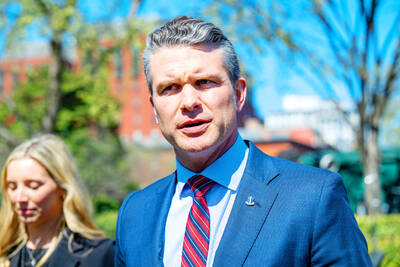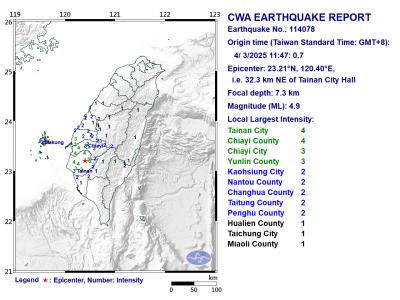On Tuesday, as President Tsai Ing-wen (蔡英文) commemorated the 228 Incident with a group of 228 victims and their families, a seminar in Taipei was taking place at about the same time attended by relatives of those who also suffered during the Incident and the subsequent White Terror era.
While both sets of people agree that the corrupt nature of the then-Chinese Nationalist Party (KMT) regime brought about the uprising that preceded the KMT’s violent suppression, they differ in how they identify themselves. The former consider themselves Taiwanese, while the latter see themselves as Zhonguoren (中國人, Chinese) and support the ideology and rule of the Chinese Communist Party.
The names of the two organizations behind the seminar are revealing. The Taiwan Area Political Victims Mutual Help Association and the Taiwan Region Association for the Settlement of Martial Law Era Political Incidents can be easily differentiated from the Democratic Progressive Party (DPP)-friendly Formosan Political Prisoner Association. Their political views are clear: Their referral to Taiwan as the “Taiwan area” is an effort to show that Taiwan is politically part of the “Mainland area.” The term is also used in the Republic of China (ROC) Constitution.
The two associations, along with the China Tide Association, the Labor Party and the Cross-Strait Peace and Development Union, are known as the “unificationist leftist faction” (統左派). The inception of this movement can be traced back to the Japanese colonial era, when the Taiwanese Communist Party was a branch of the Japanese Communist Party and to the early post-1945 period, when the “underground party” affiliated with the Chinese Communist Party thrived — and was later crushed.
They describe the Incident and the White Terror era in the 1950s as “China’s lesion inflicted by a 100 years of imperialism” and ascribe the cross-strait division to the actions of US imperialists.
The leftist unificationist faction survived the long Martial Law era, when any left-leaning speeches or thinking were instantly quashed, and the period of democratization, when such ideas were still viewed with suspicion — both due to the residue of the past and antagonism against communist China.
They are therefore not to be conflated with the Concentric Patriotism Association (CPA), founded in 1993, and the China Unification Promotion Party (CUPP), launched in China in 2004 and registered in Taiwan in 2005 by former Bamboo Union leader Chang An-le (張安樂), also known as the White Wolf. While these two groups also champion unification with China, Chinese nationalism for them trumps all other causes as the foremost and only concern.
There is an alternative pro-unification faction on the other side of the political spectrum, the right-wing pro-unification faction, made up of the Chinese Nationalist Party (KMT) and the New Party, a KMT spinoff formed in 1993 due to disagreements with then-KMT chairman Lee Teng-hui (李登輝).
Moderate KMT members might be less inclined to embrace the idea, but as KMT Chairwoman Hung Hsiu-chu (洪秀柱) keeps saying, the objective of the KMT and the ROC it brought with it to Taiwan decades ago has always been to unify China under the banner of the ROC rather than the People’s Republic of China.
The relations between the three factions is curious, as they are not inherently potential allies as might be presumed, particularly the leftist and the right-wing factions, whose ideological agendas apparently contradict each other.
The CPA and the CUPP are more or less kept at a distance by the KMT, understandably due to the former’s notoriously irrational behavior, such as attacking Falun Gong practitioners and brandishing People’s Republic of China five-star flags (bizarrely alongside ROC flags), and the latter’s organized crime background.
On the other hand, it is not surprising that the leftist unificationist faction has traditionally viewed the KMT in a negative light, considering that the regime executed and persecuted hundreds of left-leaning sympathizers and communist members in Taiwan.
At the seminar on Tuesday, speakers said that the Incident should not be appropriated by Taiwanese independence forces as the inchoate beginning of a pro-independence mentality, as it was a popular uprising against a corrupt and repressive KMT regime.
Shih Hsin University professor Wang Hsiao-po (王曉波) at one point called it “the Taiwan version of the entire nation’s [China] anti-Chiang [Kai-shek] movement.”
This narrative would certainly not be echoed by those who are striving to delegitimize the Incident by claiming (unsubstantiated) numbers of Mainlanders were killed by ethnic Taiwanese as the justification for the ensuing government-led “putting down of a riot.”
“Some of our anti-Taiwanese independence friends have been trying to cite the fact Mainlanders were also killed by the mob during the uprising, but that is not the right interpretation,” Wang said, adding that irrationality is always an aspect of popular movements and that Chinese intelligentsia in regions outside of the KMT’s control were also supportive of the uprising.
The leftist unificationist groups are on warm terms with communist China, which they refer to as the motherland, although they have no answer for how today’s China represents a socialist revolution rather than a capitalist free-for-all.

‘DENIAL DEFENSE’: The US would increase its military presence with uncrewed ships, and submarines, while boosting defense in the Indo-Pacific, a Pete Hegseth memo said The US is reorienting its military strategy to focus primarily on deterring a potential Chinese invasion of Taiwan, a memo signed by US Secretary of Defense Pete Hegseth showed. The memo also called on Taiwan to increase its defense spending. The document, known as the “Interim National Defense Strategic Guidance,” was distributed this month and detailed the national defense plans of US President Donald Trump’s administration, an article in the Washington Post said on Saturday. It outlines how the US can prepare for a potential war with China and defend itself from threats in the “near abroad,” including Greenland and the Panama

A magnitude 4.9 earthquake struck off Tainan at 11:47am today, the Central Weather Administration (CWA) said. The hypocenter was 32.3km northeast of Tainan City Hall at a depth of 7.3km, CWA data showed. The intensity of the quake, which gauges the actual effect of a seismic event, measured 4 in Tainan and Chiayi County on Taiwan's seven-tier intensity scale, the data showed. The quake had an intensity of 3 in Chiayi City and County, and Yunlin County, while it was measured as 2 in Kaohsiung, Nantou County, Changhua County, Taitung County and offshore Penghu County, the data showed. There were no immediate reports of

The Chinese Nationalist Party (KMT) is maintaining close ties with Beijing, the Democratic Progressive Party (DPP) said yesterday, hours after a new round of Chinese military drills in the Taiwan Strait began. Political parties in a democracy have a responsibility to be loyal to the nation and defend its sovereignty, DPP spokesman Justin Wu (吳崢) told a news conference in Taipei. His comments came hours after Beijing announced via Chinese state media that the Chinese People’s Liberation Army’s Eastern Theater Command was holding large-scale drills simulating a multi-pronged attack on Taiwan. Contrary to the KMT’s claims that it is staunchly anti-communist, KMT Deputy

RESPONSE: The government would investigate incidents of Taiwanese entertainers in China promoting CCP propaganda online in contravention of the law, the source said Taiwanese entertainers living in China who are found to have contravened cross-strait regulations or collaborated with the Chinese Communist Party (CCP) could be subject to fines, a source said on Sunday. Several Taiwanese entertainers have posted on the social media platform Sina Weibo saying that Taiwan “must be returned” to China, and sharing news articles from Chinese state media. In response, the Mainland Affairs Council (MAC) has asked the Ministry of Culture to investigate whether the entertainers had contravened any laws, and asked for them to be questioned upon their return to Taiwan, an official familiar with the matter said. To curb repeated